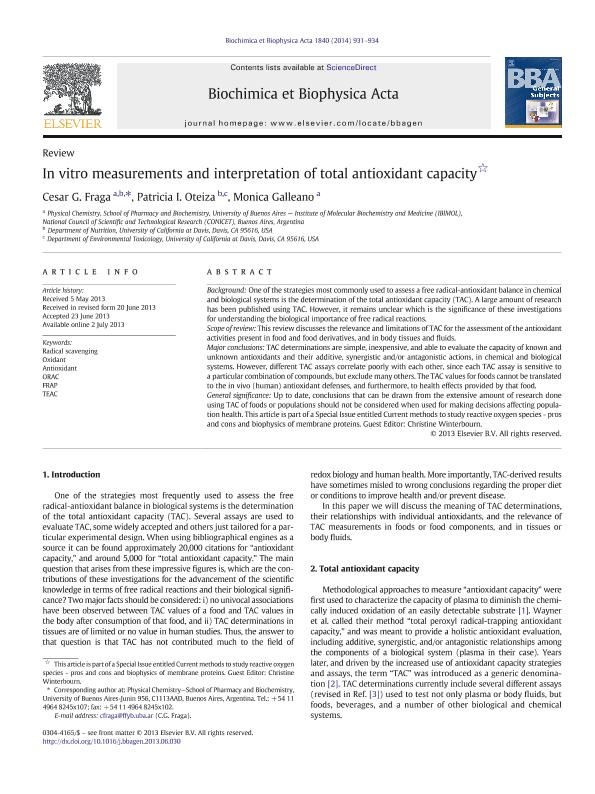Artículo
In vitro measurements and interpretation of total antioxidant capacity
Fecha de publicación:
07/2013
Editorial:
Elsevier
Revista:
Biochimica et Biophysica Acta- General Subjects
ISSN:
0304-4165
Idioma:
Inglés
Tipo de recurso:
Artículo publicado
Clasificación temática:
Resumen
Background: One of the strategies most commonly used to assess a free radical-antioxidant balance in chemical and biological systems is the determination of the total antioxidant capacity (TAC). A large amount of research has been published using TAC. However, it remains unclear which is the significance of these investigations for understanding the biological importance of free radical reactions.
Scope of review: This review discusses the relevance and limitations of TAC for the assessment of the antioxidant activities present in food and food derivatives, and in body tissues and fluids.
Major conclusions: TAC determinations are simple, inexpensive, and able to evaluate the capacity of known and unknown antioxidants and their additive, synergistic and/or antagonistic actions, in chemical and biological systems. However, different TAC assays correlate poorly with each other, since each TAC assay is sensitive to a particular combination of compounds, but exclude many others. The TAC values for foods cannot be translated to the in vivo (human) antioxidant defenses, and furthermore, to health effects provided by that food.
General significance: Up to date, conclusions that can be drawn from the extensive amount of research done using TAC of foods or populations should not be considered when used for making decisions affecting population health. This article is part of a Special Issue entitled Current methods to study reactive oxygen species - pros and cons and biophysics of membrane proteins. Guest Editor: Christine Winterbourn.
Palabras clave:
Radical Scavenging
,
Oxidants
,
Antioxidants
,
Orac
,
Frap
,
Teac
Archivos asociados
Licencia
Identificadores
Colecciones
Articulos(IBIMOL)
Articulos de INSTITUTO DE BIOQUIMICA Y MEDICINA MOLECULAR
Articulos de INSTITUTO DE BIOQUIMICA Y MEDICINA MOLECULAR
Citación
Fraga, César Guillermo; Oteiza, Patricia Isabel; Galleano, Mónica Liliana; In vitro measurements and interpretation of total antioxidant capacity; Elsevier; Biochimica et Biophysica Acta- General Subjects; 1840; 2; 7-2013; 931-934
Compartir
Altmétricas




